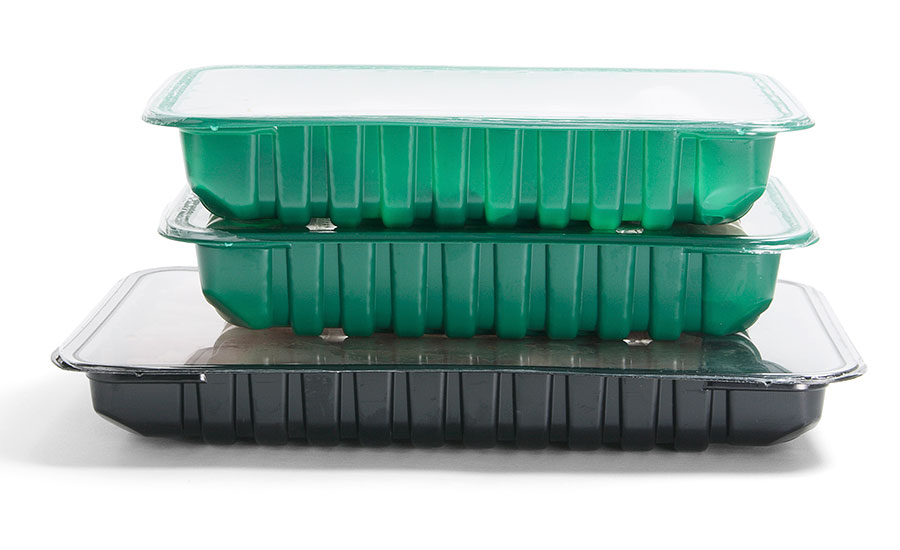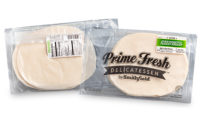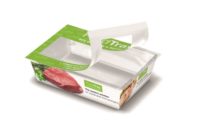Whatever your packaging format, it’s quite likely a more sustainable alternative exists.
One of the biggest sustainability-enhancing opportunities replaces rigid packaging with lighter flexible packaging. In fact, the Meat, Poultry & Seafood Packaging study, published in April 2015 by Freedonia, forecasts above-average gains for pouches.
“Demand for pouches used in meat, poultry and seafood packaging is forecast to climb 5.2 percent per year to $450 million in 2019,” the study says. Driving forces include growing demand for convenience products, expanded use of retort pouches and continued penetration of standup pouches for frozen meat, poultry and seafood, particularly for larger stock keeping units destined for club stores. “Moreover,” the report says, “sustainability benefits such as lightweight, reduced material use and significantly lower shipping costs than rigid containers will propel growth for pouches.”
The report goes on to predict, “Standup pouches will make inroads into bag, metal can and folding carton applications based on their high quality graphics, suitability for upright display, and large front panels, all of which provide merchandising advantages. In addition, pouches provide a reduction in material use compared to folding carton or plastic tub and inner pouch systems.”
Although flexible packaging tends to be viewed as highly sustainable, even it can be improved. One option is conversion from pre-made bags to bags cut from lengths of tubestock. This custom sizing eliminates the need to trim premade bags and the associated waste.
For rigid packaging, environmental impact can be minimized by sourcing renewable and/or compostable materials, source-reduced (lighter) designs, adoption of reusable containers/shippers and incorporation of recycled content.
For example, some classify the expanded foam trays commonly used to package meat, poultry and seafood as so environmentally detrimental they want the material banned. Compostable alternatives exist. Unfortunately, with the commercial composting infrastructure in its infancy, many consumers have no access to composting.
At the distribution level, wax-coated corrugated boxes are often used to transport raw meat, poultry and seafood. Unfortunately, the wax coating renders the corrugated unrecyclable, generally results in landfill disposal costs and can pose challenges to gluing. But wax-free options are available. A water-resistant acrylic- or animal-protein-based formula is added during the corrugated production process or applied as a coating. Resulting boxes are not only repulpable (recyclable), but also stronger and cost-competitive. In some cases, it’s possible to improve the environmental profile further and include recycled fiber content.
Reusables are another sustainable packaging option and can generate substantial savings as well as reduced carbon footprint. The Reusable Packaging Association (RPA) provides a Quick Calculator tool on its Web site, www.reusables.org, to help calculate the economic benefits of converting to reusable bulk packaging. Other resources include the RPA booth, Reusable Packaging Pavilion and Reusables Learning Center at PACK EXPO Las Vegas, Sept. 28-30, 2015, at the Las Vegas Convention Center.
“Attendees can find all the resources and information they need to create and support a cost-effective reusables program,” says Jerry Welcome, president of the RPA.
The Reusables Learning Center stages presentations about best practices in reusable material handling, implementing reusables and return on investment. The Reusables Packaging Pavilion houses more than 30 suppliers of reusable products and services including manufacturers, material suppliers, providers of washing and other specialty equipment, and service providers.
Reusable primary containers also deliver compelling environmental benefits. As a result, many lunch meat producers have adopted reclosable tubs consumers can reuse repeatedly. Made of polypropylene, the tubs are microwaveable, freezer-compatible and dishwasher-safe. NP







Report Abusive Comment